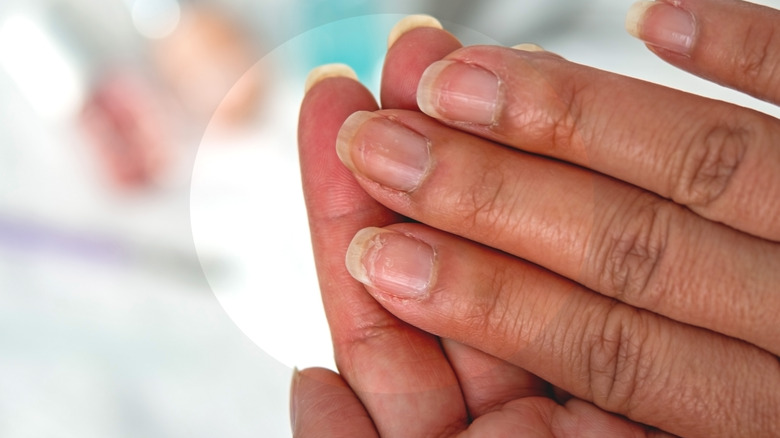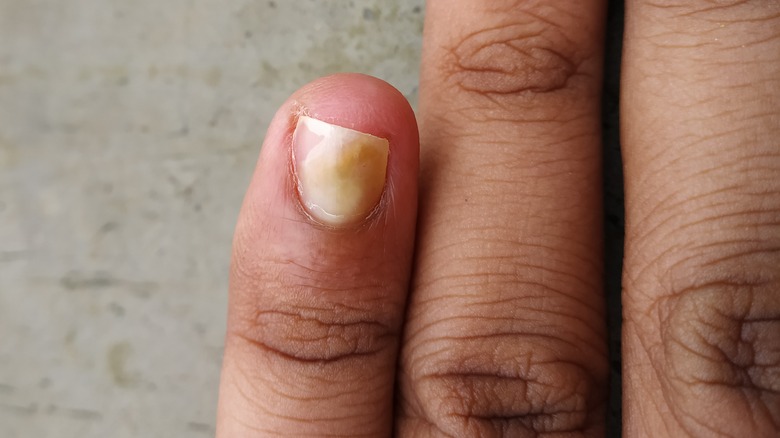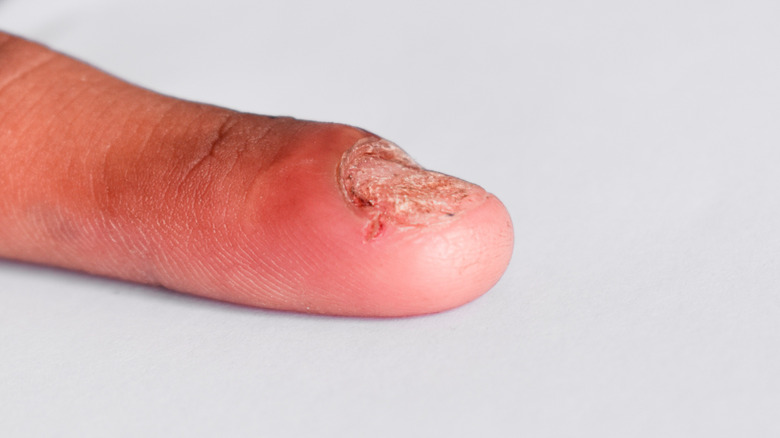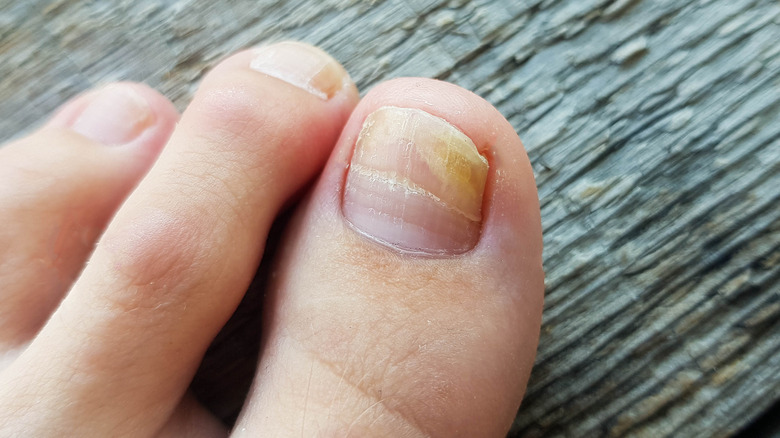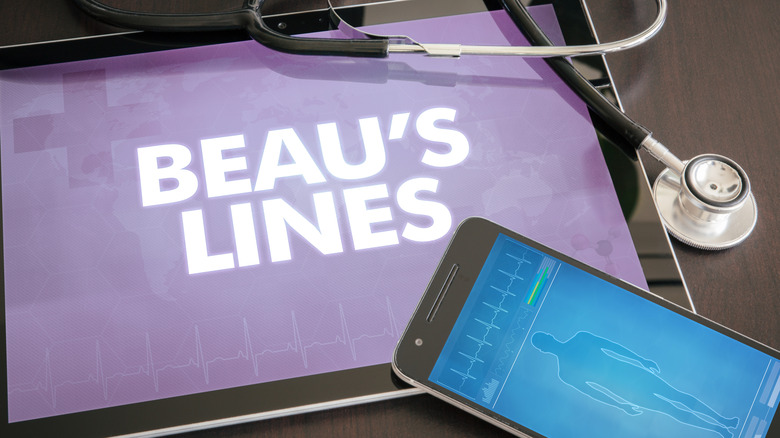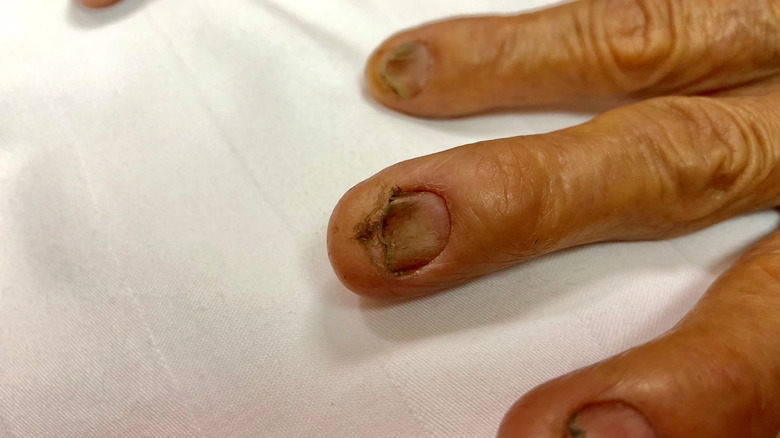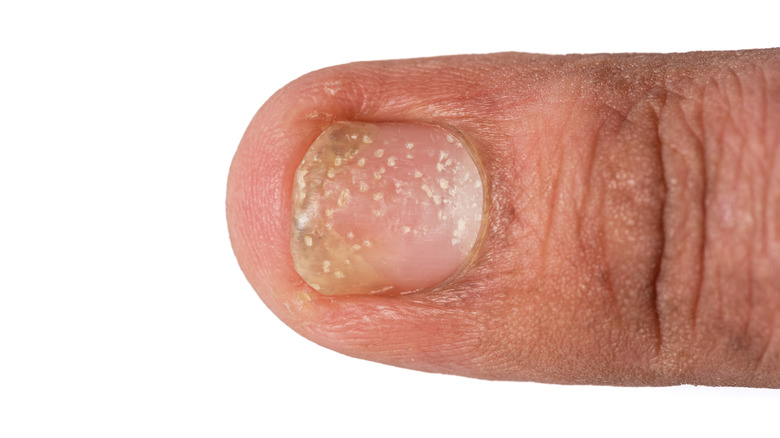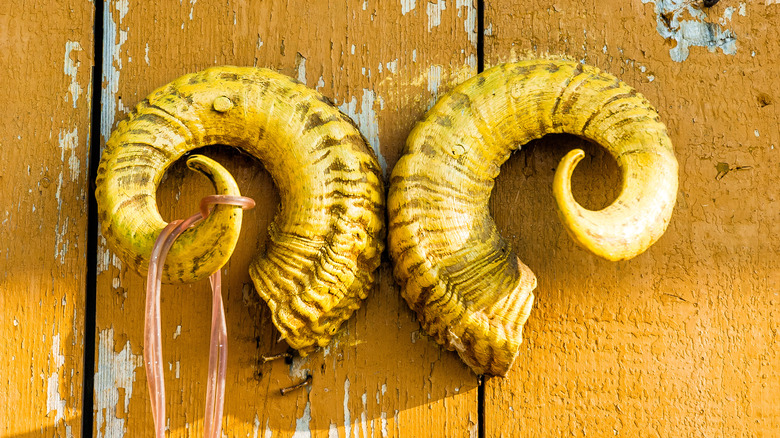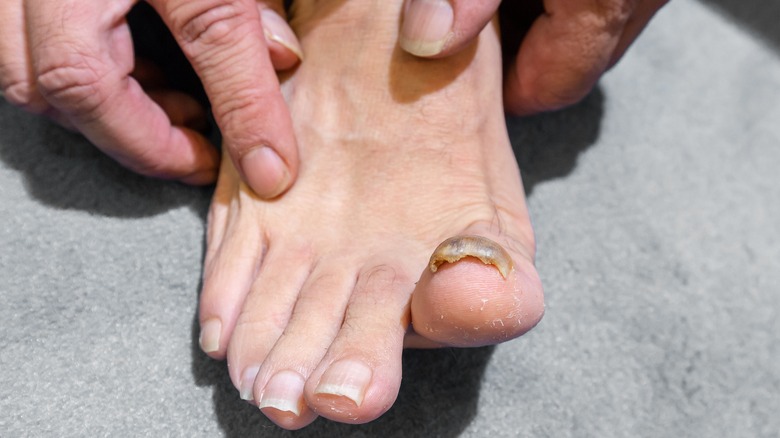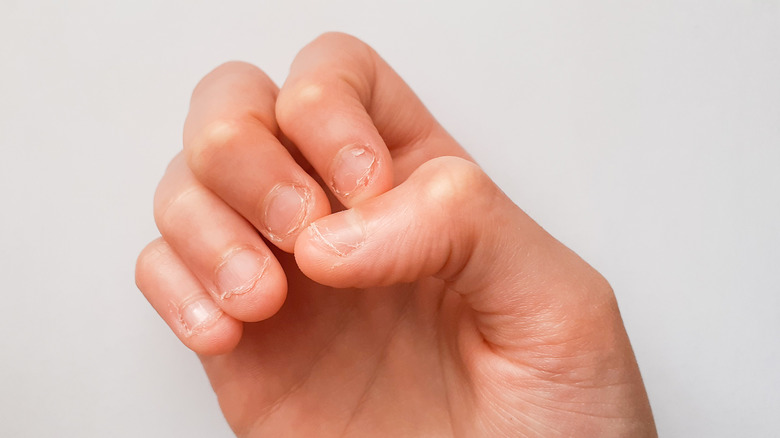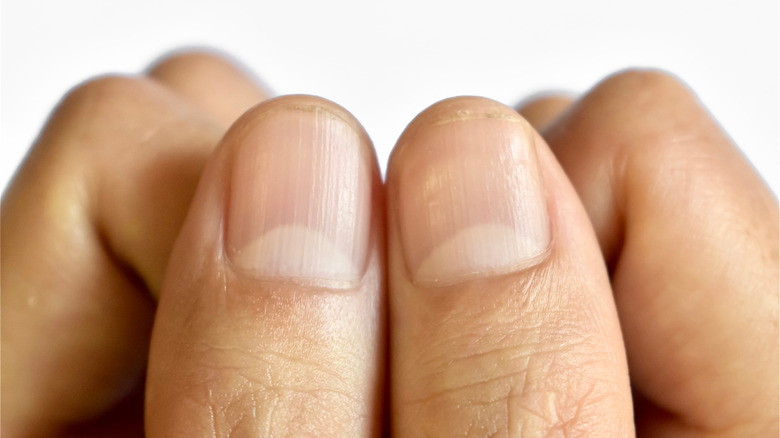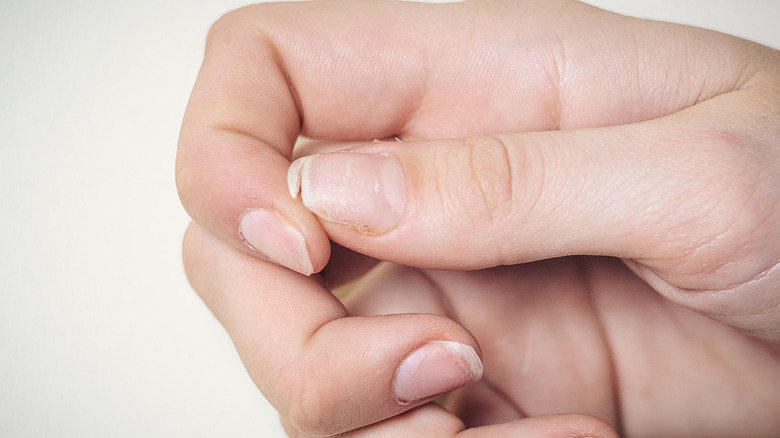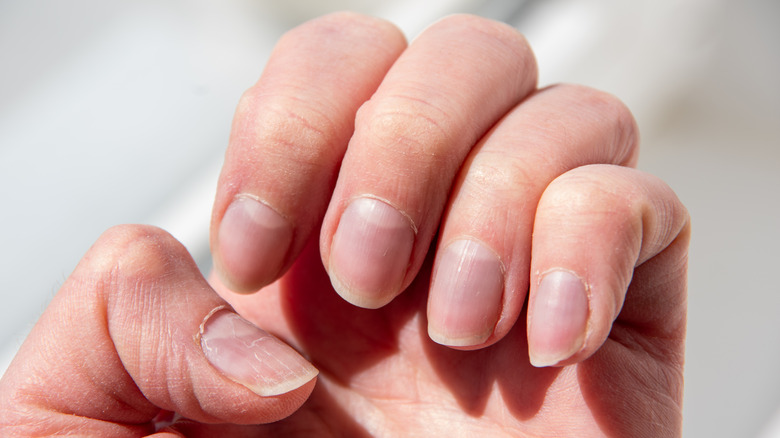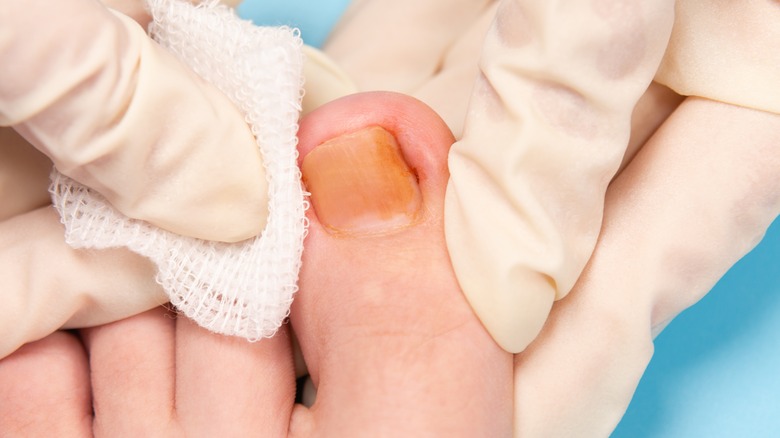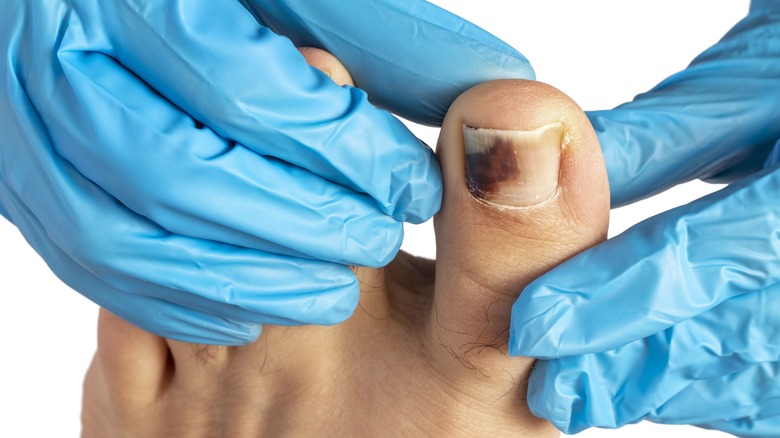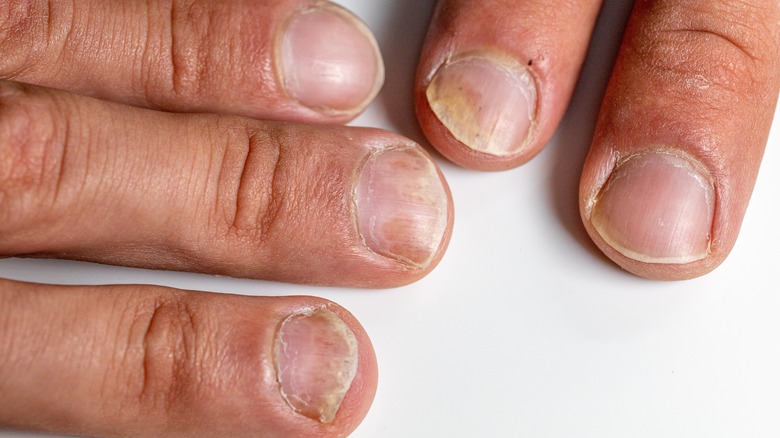What Your Nails Can Tell You About Your Health
The nails are a unique part of the body. You might love to file, buff, and slather your favorite nail polish on them; you may switch things up with false nails or express yourself through nail art; ir you might not even glance at them till it's time to snap them off. In any case, you should really be paying attention to what your nails actually look like, as they can give you clues about the state of your health, notes Patient. The nails were claws before, but they evolved (since we don't need to climb trees or slash throats with our bare hands anymore). That hard part of the nail is known as the nail plate. It helps with our grip and protects underlying structures. And how would we ever get that satisfying scratch without it? The nail plate grows out of the nail matrix, which is hidden by the skin and cuticle. It has the nail bed underneath and nail folds on its sides.
Normally, the nails are meant to be strong, smooth, and evenly colored, per the Mayo Clinic. Any strange nail changes could be because of bad nail care or be a sign of a health condition. These could be less obvious signs, like when the strength, texture, or growth pattern of the nails change. Or it could be obvious, like discoloration, bleeding, pain, swelling, or separation. It's important that you don't ignore any abnormal signs but report them to your dermatologist.
Here's why your nails are soft, brittle, or flaky
It can be frustrating to have weak nails that keep breaking off, whether they are soft and bendy or dry and brittle. The nails usually feel a bit weaker when you remove faux nails. Your nails might get weak after you've used some nail polishes, nail polish removers, or nail treatments because they contain harsh chemicals. Some everyday products contain harsh chemicals which could weaken your nails if they are unprotected. These include dishwashing soaps, detergents, and cleaning fluids. Your nails might also get weak and soft because you repeatedly get them wet. Healthline adds that weak nails could be caused by not moisturizing your nails after wetting them but leaving them to dry out, especially in cold or dry weather.
Weak nails can also be a sign of a health condition, especially if you notice that your toenails and fingernails are not strong. These conditions include hypothyroidism which is often accompanied by hair loss, weight gain, depression, and constipation, or Raynaud's syndrome, which is caused by problems with blood circulation, says Healthline. Missing certain nutrients in your diet can also weaken your nails. These include B vitamins, calcium, omega-3 fatty acids, biotin, and iron.
What unusual nail colors mean
The nails are normally meant to have a flesh-colored or pinkish tint. There's a problem if your nails turn white, yellow, bluish, greenish, brown, purple, red, or gray. An abnormal discoloration could come as a patch, spot, line, or spread across the nail. And they are usually one of the symptoms of health conditions. It could be circulatory problems, cancer, lung, kidney, heart, or liver problems, bacterial or fungal infections, allergies, or nutrient deficiencies, depending on the color. So, you should get your nails checked by your doctor and treat the underlying condition (via Disabled World).
Not all unusual colors that appear on the nails should make you panic. For example, it's common for folks with dark skin to have brown streaks or lines on their nails, notes Good Rx Health. This is known as melanonychia. However, it could be a sign of a melanoma, especially if the lines extend to the skin fold. White spots on the nails could come from a nail injury or trauma. And if there's bleeding, purple or red spots from a blood clot should be expected. These typically go away after the nail has healed and grown out.
What causes a swollen nail fold?
The nail fold swells up when it gets inflamed, and this is known as paronychia. Nail inflammation is usually the result of a bacterial infection. Bacteria can get into the nail fold through hangnails, injured or irritated skin, ingrown nails, or nail trauma from biting, accidents, or getting too many manicures or pedicures in a short time. Nail inflammation could also be a side effect of drugs like oral retinoids, antibiotics, cancer, or HIV medications. Whatever the cause, an inflamed nail fold doesn't only swell, it is red-hot painful and could contain pus that accumulates to form an abscess. It can also cause major damage to the nail — make it separate from the bed and fall off, or make new nails grow out deformed, discolored, or flaky. And this damage remains even after the inflammation has healed (via the Cleveland Clinic).
Some people have an awful memory of the one time they had a swollen nail fold. But there are people who experience this several times, for long periods (more than six weeks), and in more than one nail (sometimes). This is known as chronic paronychia. While the cause is not completely understood, it is most commonly seen in individuals whose hands frequently get cold and wet or who have hand dermatitis. These could be bartenders, fishermen, dairy farmers, cleaners, or people with poor circulation (via DermNet).
What these bad nail habits could indicate
There are many bad nail habits. But attacking and damaging the nails through biting or picking is particularly problematic. Occasional nail biting or picking is not usually a cause for concern. These habits are also common among children and teens, who eventually outgrow them. However, Healthline notes that there might be a problem if your nail biting or picking brings shame or is so consistent and uncontrollable that you can't stop even when you injure yourself. In this case, nail biting or picking is seen as a body-focused repetitive behavior — uncontrollable acts that damage the body. Other examples of these behaviors include compulsive teeth grinding, cheek biting, hair pulling, or skin picking.
Nail biting or picking could be because of an anxiety disorder, says Healthline. This is usually accompanied by other signs like phobias, sleep problems, muscle tension, irritability, trouble concentrating, or always feeling tired. These bad nail habits and other body-focused repetitive behaviors could also be signs of obsessive-compulsive disorder, attention deficit hyperactivity disorder, oppositional defiant disorder, separation anxiety, or Tourette's syndrome,
What makes the nail separate from the nail bed?
The nails are normally attached to the nail bed, except the part that grows off the tips of your fingers or toes. But they can actually peel off the nail bed, which in medical speak is called onycholysis or nail separation. Per the Cleveland Clinic, this can happen to anyone but is more common among women, adults, and people with conditions that affect the nail bed. A separated nail is usually accompanied with bleeding, discoloration, or damage.
Nail separation can be caused by trauma from hitting the nails too hard, wearing tight shoes, frequent manicure or pedicure sessions (especially if they're too rough), or soaking your nails in water for too long, says the Cleveland Clinic. People who have nail infections or skin conditions like hand dermatitis, psoriasis, or lichen planus are prone to nail separation. It could also be caused by some medications or be a symptom of conditions like diabetes, pregnancy, or light sensitivity. And sometimes, the cause may not be identifiable. Apart from not looking good, a separated nail also leaves the finger open to new infections (via DermNet).
What it means when ridges appear on your nails
The nails are not totally smooth to the touch. However, it's abnormal for them to develop prominent ridges. These ridges could run across the nail (horizontally), and the medical term for this is Beau's lines. Or they could be longitudinal, and this is called onychorrhexis. Longitudinal ridges aren't typically a cause for concern. They could just be how your nails look or a part of getting older. Longitudinal ridges could also be caused by nutrient deficiencies, eczema, anemia, amyloidosis, hypothyroidism, trauma, or exposure to harsh products (via Healthline).
Beau's lines could develop after serious illnesses like mumps, strep infections, pneumonia, Covid19, or a heart attack, says the Cleveland Clinic. The body may direct all its resources to survive when you are really ill and since forming a new nail is not as important, your nail growth might be interrupted. Beau's lines could also be caused by trauma to the nail matrix. Beau's lines caused by illnesses or trauma usually appear weeks after the incident, when the affected nail eventually grows out. Beau's lines could be a recurrent problem if they are caused by long-term illnesses that limit blood supply to the nail matrix or skin conditions that damage this matrix.
You need to see your doctor if your nails bend upwards or downwards
If your nails bend upwards as they grow out, this is known as nail spooning or koilonychia. The nails may grow out flat initially and then form a depression, taking on the shape of a spoon. The depression is usually deep enough to hold a drop of water, per Medical News Today. Some babies are born with spoon nails and grow out of it. But nail spooning in an adult is most often a sign of an illness — iron deficiency anemia in most cases. It's also associated with heart problems, hypothyroidism, lupus, some skin and genetic conditions, and nail trauma, amongst others. Environmental factors like living in a high altitude or using petroleum-based products can also cause nail spooning.
Nails that curve downward at the fingertips are known as clubbed nails. They typically look wide, round, and bulgy, like an inverted spoon, says the Cleveland Clinic. Clubbed nails may also feel warm, soft, and springy. The skin surrounding the nails usually looks red and swollen. Nail clubbing is most often a symptom of lung diseases like lung cancer. It could also be a sign of heart, thyroid, liver, or digestive diseases. Some people develop clubbed nails for no identifiable reason, and nail clubbing runs in families. The clubbed nails don't usually cause any pain. But the underlying issue needs to be treated so that the nails can eventually grow out normally.
What is yellow nail syndrome?
Yellow nail syndrome is a really rare condition whereby the fingernails or toenails develop a yellow color, curve, thicken, and stop growing but are still clear and smooth, per the National Organization for Rare Disorders. The nails lose their cuticle and may get loose, separate from the nail bed, and even fall off. The nail area is vulnerable to infections when the nails are in this state. Most cases of yellow nail syndrome are seen in older adults and are usually accompanied by breathing problems and swelling of different parts of the body.
The nails look like that because lymph, a fluid containing immune cells, collects under the nails, notes WebMD. Lymph usually flows through the body, and conditions that make it stagnant, like lymphedema, can lead to yellow nail syndrome. It is also associated with breast and lung cancers, immune deficiency diseases, autoimmune diseases, genetic mutation, and metallic titanium poisoning. To manage this syndrome, the symptoms of yellow nail syndrome, lymph buildup, and any underlying diseases are treated.
Nail pitting is a classic sign of nail psoriasis
Nail pitting happens when the fingernails or toenails develop "deep or shallow holes," per Healthline. Although nail pitting could be caused by other conditions, it's a common feature of psoriasis, a skin condition that causes an excess buildup of skin cells. Nail psoriasis affects half of the people with psoriasis, especially those who develop psoriatic arthritis. And it might affect people who have no other symptoms of psoriasis. Other symptoms of nail psoriasis include thickening, discoloration, deformation, and peeling of the nail.
The Psoriasis and Psoriatic Arthritis Alliance emphasizes the importance of nail hygiene for individuals with nail psoriasis. This includes trimming the nails, applying moisturizers to the cuticle, protecting the nails from further damage, and soaking nails in warm water to remove dirt or before filing. Nail psoriasis can be treated using steroid or vitamin D creams, drugs, and procedures like nail removal or steroid injections. It will take months to notice any improvements and over a year for full recovery. So, they advise you to be patient with treatments.
This nail disorder makes the nail's look like a ram's horn
The condition is medically known as onychogryphosis but nicknamed ram's horn nails. This is because the affected nail — which is almost always the big toenail — elongates, thickens, and then curls resembling a ram's horn, says News-Medical.net. The nails become really thick such that they can't be clipped without professional help and require medical treatment. Per Healthline, other symptoms that accompany the disorder include nail infections, yellowing or browning of the nail, ingrown nails, pain, and unwillingness to perform certain activities.
One might develop this condition after foot trauma or by neglecting basic nail care, notes News-Medical.net. This means that people who wear tight shoes, homeless people, dementia patients, or older people who may forget to care for their nails are at risk. The condition could also be one of the signs of diseases like psoriasis, ichthyosis, peripheral vascular disease, or tuberous sclerosis complex, notes Healthline. People who have had nail fungal infections or currently have these infections may develop ram's horn nails.
Got thick toenails? Here's what could cause it
The toenails (and the fingernails to some extent) normally thicken as a person gets older. But if you notice an unusually thick toenail, it could be a sign of a fungal infection, per Medical News Today. Thick toenails could also develop as a result of repeated trauma to the nails. They could also be a sign of conditions like psoriasis, yellow nail syndrome, or chronic paronychia (swollen nail fold).
Whatever the cause, you need to get thick toenails checked and treated, especially if it's from a fungal infection. Leaving the infection untreated can thicken the nails even further. And this might make wearing covered shoes or simply walking uncomfortable, notes Healthline. You may notice other symptoms from a nail fungus, like a collection of dirt under the nails, discoloration, a bad smell, nail breakage, nail separation, and the affected nails may look dry and whitish, states the site.
What could make your nails grow slowly?
It can be frustrating when your nails just won't grow. Maybe you're recovering from a nail disorder or nail damage and can't wait for the bad nail to grow out. Or perhaps you simply want to grow them just a bit longer. The nails actually grow slowly — it's not shocking if you really think about it. So, don't stress about it. Healthline notes that the fingernails only grow only about 3.47 millimeters in a month, while the toenails grow about 1.67 millimeters in a month. It would take up to half a year for the fingernails to be completely replaced and a year and a half for the toenails. And this growth rate slows down as you get older.
There are some things you might be doing or neglecting that could slow down your nail growth. This could be biting your nails, doing dishes without gloves, eating an unbalanced diet, not moisturizing your cuticles, filing your nails, or getting them done too often, says Fustany. Certain nail products like nail polish removers containing acetone or poor-quality nail polishes could also be responsible for slow nail growth. Healthline adds that you can encourage growth by clipping and cleaning your nails, taking a biotin supplement, or using a nail hardener. They warn that using hardeners too often can eventually damage the nails.
Though small, the half moon on your nail can reveal lots about your health
You might not really think of the white, half-moon-shaped area at the base of your nails, also called the lunula. But it has lots to say about your health. It's actually a part of your nail matrix that your skin doesn't cover. So, many people can see it through their nails. However, some people might not see their lunulae or only see that of their thumb. This is not really a cause for concern as factors like your skin color can conceal it. Healthline adds the lunula could simply be covered by your skin or cuticle. An absent lunula could also be one of the signs of malnutrition, anemia, or depression. Some people may have an overly large lunula. While it's not clear why this happens, it might be due to low blood pressure or other heart problems, says Healthline.
Certain health conditions could change the color of the lunula. These include heart failure, which turns the lunula red, chronic kidney failure, which gives it a brown color, uncontrolled diabetes, which could give the lunulae a pale blue color, and Wilson's disease, a rare condition that could turn the lunulae blue. Excess amounts of certain chemicals in the body can also change the color of the lunulae. A blue-gray color can indicate silver poisoning, brown or black, excessive fluoride ingestion, and taking tetracycline medications for a long time can turn the lunulae yellow.
Signs your nails need a break from polish
It is a common myth that you should remove nail polish periodically to let your nails breathe. Not only do nails not breathe, they acquire the oxygen and nutrients they need through the bloodstream (per the Wexner Medical Center), which means they don't actually require a physical break between manicures to maintain their health and strength. However, it isn't a bad idea to leave your nails bare on occasion, especially if you like to partake in regular gel or acrylic manicures.
Common signs of nail damage as the result of wearing nail polish are peeling, thinning or bendable nails, brittleness, and breakage. Keratin granulation, or white stains on the nails, is caused by prolonged wear drying out the nail beds. This usually requires a break from polish to see nails return to their normal color. "Depending on how quickly your nails regenerate and the severity of the discoloration, your nails can take anywhere from one week to a few months to return to a healthy color," Adina Mahalli tells the Sunday Edit. The abrasive removal of gel and acrylics, via picking or an impatient manicurist, can also lead to significant nail damage over time.
If you notice your frequently painted nails aren't looking their best, work on implementing a proper nailcare routine. Applying a moisturizing cuticle oil rich in Vitamin E, antioxidants, or jojoba oil to the nails between manicures can help transform the condition of your nails. Taking a biotin supplement may also help strengthen brittle nails.
How to combat dry cuticles
Cuticles, or the soft, thin layer of skin found at the bottom edge of your fingernails and toenails, is necessary for protection against bacteria and fungus, per Healthline. They are responsible for keeping the nail matrix, or the place where your nails form, safe and healthy. Unfortunately, this skin is extremely delicate. It is prone to drying out, flaking, peeling, and cracking. Several factors cause these problems, including dry, hot, or cold air; improper hydration; excessive handwashing; or using harsh nail polish removers. People who bite their nails or use too much hand sanitizer are also prone to experiencing dry cuticles.
Although dry, damaged cuticles are not typically a sign of a serious health condition, people with dry, itchy skin conditions like eczema may experience dry cuticles more frequently. This can lead to inflammation, redness, and pain around the nail bed if left untreated, especially if their damaged state allows unwanted dirt and bacteria to enter the nail bed and cause an infection.
Eating a diet rich in vitamins and minerals, drinking plenty of water, and wearing proper sunscreen can prevent this. Cuticle oils and hand creams will also help keep the cuticles hydrated. "A good moisturizer for the cuticles is important, just like for dry skin," dermatology professor Dr. Richard Scher tells Radiance by WebMD. "Any skin moisturizer will work fine for the cuticles. When you put it on your hands and there's some left over, rub it into the cuticles."
What does a red, painful toenail mean?
If you've ever trimmed your toenails and felt a sore, sensitive, and inflamed toe a few days later, you have likely experienced an ingrown toenail. Ingrown toenails are a common problem, affecting teenagers and adults over 50, and resulting in 20% of all reported foot issues (per Informed Health Online). Improperly cut nails and poorly fitting shoes are the most common culprits for this painful nail growth, which occurs when the nail's edge begins to curl and embed into the flesh of the toe.
Depending on how quickly you notice an ingrown toenail developing, you may be able to treat it at home. Epsom salt soaks target inflammation and are ideal for easing the pain of an ingrown toenail. Additionally, applying an over-the-counter antibiotic ointment to the affected area can take care of a developing infection. Unfortunately, ingrown toenails can turn ugly fast and require the attention of a medical professional, who may prescribe antibiotics or apply a splint to help correct the toenail's growth. Depending on the severity of the injury and how regularly you experience ingrown toenails, a doctor may need to perform surgery to remove all or part of the toenail.
Identifying the causes of a black toenail
A surprise purple-black spot under your toenail may feel like cause for alarm, but it is often diagnosed by a doctor as a subungual hematomas (per StatPearls). Although this diagnosis might sound intimidating, it is simply the result of bleeding under the nailbed, caused by the toenail getting crushed or slammed. Black toenails can occur from poorly fitted shoes, one-time injuries like stubbing your toe, or dropping a heavy object on it. They are often accompanied by a painful throbbing due to breaking the blood vessels, and the black color is the result of blood pooling beneath the skin.
To treat a painful, black toenail, you must visit your doctor to have it diagnosed and drained with a simple pinprick. During this visit, they will also be able to determine if any bones were broken. Most dark patches resulting from trauma will heal on their own, and the discoloration will grow out. However, any changes in look or feel should always be examined by a doctor.
Some nail deformities indicate rare health conditions
Certain nail deformities like pincer nails, parrot beak nails, or congenital nail anomalies can be indicators of certain health conditions or medical treatments for other issues (via a 2020 article published in BioMed Research International and a 2021 article in Cureus). For example, pincer nails, or overly curved nails, can occur from fungal diseases or medications like beta-blockers. Parrot beak nails are a rare deformity involving a forward curvature of the finger or toenails that resembles a bird's beak, resulting from drug use, bone abnormalities, or nail trauma.
Nail-patella Syndrome (NPS) is a rare genetic disorder that affects the knees, elbows, and pelvis in addition to the appearance of the finger and toenails, per MedlinePlus. With this condition, individuals may have ridged, discolored, or pitted nails, if they are present at all. Thumbnails in particular are often missing or irregularly shaped. People with NPS may also have triangle-shaped areas at the base of their nail beds in lieu of half-moon-shaped circles.

